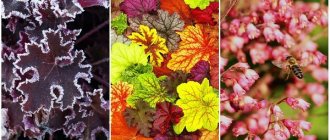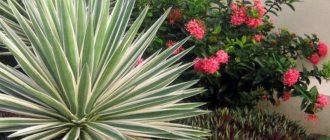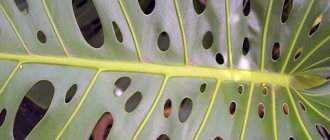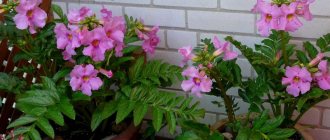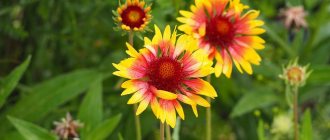The rhizomatous perennial herbaceous plant Heuchera is a member of the Saxifraga family. Today its varieties and types are highly valued in landscape design.
Photo. Heuchera in a flower bed.
Did you know that... This plant was named after the German doctor and botanist Johann Heinrich von Heicher.
The cradle of culture is the rocky regions of North America.
Heuchera bushes are compact, reach a height of about 50 centimeters, and are valued for their spectacular foliage, which attracts the eye with its sophistication.
A distinctive feature of the plant is that during one growing season its foliage can change color several times.
This crop is distinguished by an incredibly diverse color palette, as well as many options for combinations of color shades, especially for modern variegated varieties.
Brief description of the plant
- Landing. In spring, suitable months are March-April.
- Bloom . Observed in June-August.
- Lighting. Grows well in shade or in bright, but diffused light, without direct sunlight.
- The soil. Must be moisture-resistant, breathable and water-permeable with a pH of 5.0-6.0.
- Watering . Systematically water the plant when the soil dries out once every two to three days. During long periods of warm, dry weather, water the flower twice a day.
- Fertilizer . Feeding begins from the second year of growth, this is done before flowering and after flowering. To do this, use liquid complex mineral fertilizers in half the dose recommended by the manufacturer.
- Reproduction. By dividing the bush into cuttings, as well as sowing seeds.
- Insect pests. Weevils, leaf nematodes, butterfly caterpillars, snails and slugs.
- Diseases. Gray rot, stains, rust, powdery mold.
How to transplant?
Heuchera flowers should be replanted in the spring or if necessary - for example, when the bushes need a change of soil, or the previous pot has become cramped
Here it is important to observe the planting depth, or place the bushes in such a way that they are slightly deeper than the level at which they were in the previous case
If there are no hints of rot or other dangerous diseases on the plant, then instead of replanting, you can resort to transshipment of the bushes. They should simply be transferred to a new pot along with the old lump of earth. Such a procedure will be completely non-traumatic for the roots of the flower; it will quickly adapt to new conditions and begin to grow.
If there is a suspicion that root rot is occurring, then the flower needs to be replanted with a complete replacement of the substrate. In this case, the roots need to be thoroughly disassembled and carefully examined. Roots affected by rot and old roots should be cut off with sharp pruning shears, and areas with cuts should be treated with special fungicidal agents and sprinkled with powdered charcoal.
Transplantation of previously diseased plants can be carried out exclusively into fresh substrate, because pathogens of the disease may still remain in the former one. After replanting, the soil will need to be compacted with your fingertips to prevent air pockets from appearing. After these procedures, you should not water the flower for several days, nor should you expose it to the sun.
Heuchera transplantation is also necessary if you are propagating it by division. Of course, these procedures are easier for experienced flower growers, but beginners can also do them by following some simple rules.
- Bushes can be divided in autumn or spring, every 3-4 years. This is how the plant rejuvenates and reproduces. Otherwise, the flower may “go bald”.
- Early autumn or towards the end of spring is the ideal time for planting.
- The bush must be very carefully dug up and then divided into 2-3 parts.
- Next, you need to take a knife and carefully cut the rhizomes into approximately equal parts. It is advisable to preserve the soil on the roots so that the seedlings can quickly take root in a new place.
- Sprouts should be planted according to the usual pattern, not forgetting about abundant watering.
The suitable hole size for planting the separated part is 20x30 cm. A distance of at least 25 cm should be maintained between the transplanted bushes. Upon completion of the planting process, the flower must be watered and the space around the trunks must be mulched.
If soon after planting there is a need to replant a young plant, then this can be done no earlier than the next season. This is due to the fact that the root system of young heucheras is quite delicate; when replanting, there is a risk of damaging it and ruining the bush.
Plants older than two years of age tolerate transplantation well, however, special care must be taken when moving them to a new location.
Appearance
Heuchera is a compact and dense bush, which consists of blades of long-leaved, leathery leaves with a jagged edge.
Photo. Heuchera leaves.
The color and shape of the leaves are very diverse. They can be almost black, brown, pink, yellow, deep red, amber, purple, green and even silver, and have various veins, patterns and spots on their surface. The texture of the leaf plates is corrugated, smooth and curly. The bushes are decorated with flowers throughout the summer, and in some cases even until the first frost.
Photo. Heuchera flowering.
Paniculate inflorescences consist of small bells of white, red, pink or cream color. The fruit is a capsule containing many seeds the size of a poppy seed (1 g contains about 20,000 seeds).
Heuchera care
The most popular and in demand in garden floriculture are rhizomatous perennials. These are very hardy, unpretentious plants with unique decorative qualities. Most often in gardens you can find representatives of the Saxifraga family; the “highlight” of the site is undoubtedly the heuchera, which can change colors several times throughout the season. The flower received its name in honor of the German botanist Johann Heinrich von Heicher.
In the first half of the last century, flowering varieties of heuchera were most popular, but today in gardens you can mainly see decorative deciduous plant species.
Homeland and appearance
Under natural conditions, heuchera is found in North America, mainly in the rocky part. Here the plant grows up to half a meter in height.
Heuchera is a compact, dense bush. The leaves are leathery, attached to long cuttings. The shape and color palette of the leaf plate is very diverse and varies depending on the variety and type of plant. Today you can grow heuchera in the garden with green, burgundy, red, amber, purple, pink, silver, spotted leaves. Also, the leaves vary in texture, there are corrugated, curly and simple smooth.
On flowering heuchera varieties, inflorescences appear in early summer and persist until autumn. Heuchera flowers are paniculate inflorescences formed by bells of predominantly white color, sometimes red, pink or beige.
At the end of flowering, fruits are formed on the plant - boxes with small seeds (no larger than a poppy seed).
The most popular types of flowers are American heuchera (decorative-deciduous) and blood-red heuchera (decorative-flowering).
The main secret of the plant’s attractiveness and popularity is its extraordinary endurance and unpretentiousness. However, even for such a persistent plant, there are certain growing features, which include good drainage of the site and the right choice of soil - light and nutritious.
Watering mode
Heuchera needs regular watering, but the soil should dry out a little between waterings. Optimal watering schedule: every other day. Experts note that excess moisture is more dangerous for a plant than a slight drought, which is why it is better to forget to water the bush than to overdo it. In hot summers, you can water the plant twice a day - early in the morning and in the evening.
To protect the leaves from burns, you need to pour water under the root.
Lighting mode
An important condition for the successful cultivation of heuchera is the correct choice of location. The brightness of the color of the leaves will depend on this, and in the case of flowering species, the abundance and duration of flowering.
The vast majority of heuchera species prefer light partial shade. It is better to choose an area in the garden where there is direct sunlight in the morning.
Young heucheras need more lighted places, but carefully protected from drafts. In areas with bright sun, flowers with burgundy leaves will become more saturated, and on spotted leaves the pattern will appear more clearly.
The only place where it makes no sense to plant heucheras is in lowlands where rain or melt water stagnates.
Feeding and fertilizer
Considering that under natural conditions, heucheras grow in mountainous areas where soils are poor, cultivated varieties need a fairly large amount of nutrients. In the spring and summer, complex mineral fertilizers are used.
After fertilizing, the soil around the plants must be loosened.
The soil
Proper soil structure is an indispensable condition for successful growing of a plant. The soil needs to be light, well-drained, nutritious and moisture-absorbing. Sand is used for drainage. Optimal soil acidity is from 5 to 6 pH.
To preserve moisture in the soil around the heuchera, gardeners recommend spreading mulch in a layer of at least 5 cm on the site. Tree bark or compost can be used as mulch.
Characteristic
If you do not plan to collect seeds, you can cut the flowers.
It is not difficult to grow heuchera on your own plot, but it has several features that a gardener who decides to grow this perennial species should know:
— If you grow decorative and deciduous varieties of heuchera, then you need to cut off the flower stalks that appear in the bushes; they tower above the plants and look extremely disorderly. Peduncles are left only if the seeds are going to be collected in the fall.
— In decorative flowering varieties, the flower stems are cut off immediately after flowering. The lower foliage flies off over time, which negatively affects the decoration of the plant.
And a note! Before the bush begins to bloom, it is taken out of the ground and planted in a new, deeper hole with clods of earth, thanks to this it will be possible to hide the bald trunk.
- Young foliage begins to grow in rich, translucent colors (similar to flower petals), but becomes darker and denser over time.
— Heuchera bushes go well with daylilies, primroses, astilbe and ornamental grasses.
Types, varieties
The following types of heuchera are cultivated in the garden:
- American . Forms rosettes, which are valued for their purple coloring on the underside of the leaf with a brown tint (see photo).
- Hairy . The leaves of this plant seem to be woven from velvet, and the flower stalks have a feathery edge.
- Blood red . This plant has beautiful not only leaves, but also inflorescences, painted in a rich carmine color.
Species flowers are rarely grown in the garden today. Mostly varieties bred on their basis are cultivated (more than two hundred of them have been bred). They can be divided into groups. The most popular of them are:
- Silverleaves : Mint Frost, Stormy Siz, Kan Kan, Regina.
- Redleafs : Purple Castle, Black Bird, Cherry Cola.
- Yellow leaves: Marmalade, Key lime pie, Citronelle.
- Spotted: Midnight Rose, Colored Dreams, Hercules.
Planting heuchera in open ground
We plant heuchera.
Illustration taken from open sources. What time to plant?
Plants are planted in open ground in March-April. This plant loves shade and partial shade, so we recommend choosing an area that will be shaded by other crops. The diffused sun should fall on the flower.
On a note! Choose a place located in the western or eastern part of the garden; direct sunlight should fall on it only in the morning or evening.
If a sunny zone was chosen for the heuchera, the plant will need to be watered systematically and very abundantly. It was noted that if varieties with bright foliage are grown in well-lit open areas, then their color becomes more saturated and spectacular. It should be noted that varieties with red foliage are recommended to be grown only in sunny areas, otherwise their color will be green after shading.
How to properly sow heuchera seeds for seedlings: step-by-step instructions
In order for all the seeds of this crop to germinate successfully, it is necessary to plant heuchera seedlings according to the correct scheme:
- If the container you choose does not have drainage holes, carefully make them. And then put a thin drainage layer on the bottom of the container (literally 1 cm), perlite or brick chips are perfect.
- Fill a box or bowl with soil and level the surface of the ground.
- Before planting the seeds, moderately moisten the soil surface with a fine spray bottle.
- Mix small heuchera seeds with a small amount of sand.
- Scatter the seeds evenly over the surface of the soil. Sowing is superficial; you cannot cover them with soil or sand.
- Now you need to moisten the soil with the seeds again from a spray bottle, but this must be done very carefully, preferably at a short distance, so that the drops do not wash out or deepen the seeds. The water should be clean and warm.
- Now you should cover the container to create greenhouse conditions. You can cover with transparent cling film or glass.
- Place the crops in a warm and bright place (but not in direct sunlight).
The soil
The culture is not particularly demanding on the soil and can grow on any soil except acidic soil; it is better if the pH is 5-6. It can grow on rocky soil, as the plant is naturally found on the rocky shores of the Great Lakes of North America.
On a note! Remember that the looser and more nutritious the soil, the more spectacular and dense the bush will be.
Particular attention should be paid to the moisture capacity of the soil, and it must allow water and air to pass through well. The plant reacts negatively to stagnant fluids in the root system.
Description of Heuchera
Heuchera is a perennial representative of the Saxifraga family. Heuchera was first discovered in the mountains of western North America. Gradually this plant spread to other regions.
Heuchera is a perennial representative of the saxifrage family.
The main feature of heuchera is its leaves, which have a wide range of colors. The freshness and decorativeness of this plant is preserved from early spring until the onset of the first cold weather. Therefore, heuchera is used very often in landscape design. In the photo you can see various options for using this plant to decorate the garden and local area.
Landing rules
Heuchera seeds ripen after flowering.
Heuchera can be grown from seeds, or you can buy ready-made seedlings. Sowing is done in prepared loose soil and covered.
On a note! If you want to grow a crop from seeds, keep in mind that the seedlings cannot retain the varietal characteristics of the mother plant, and all you can grow is a simple bush with green foliage.
If you decide to grow a flower from seeds, we recommend doing it through seedlings. The seedlings are grown in a greenhouse, after which they are planted in open ground, maintaining a distance between bushes of at least 20 centimeters, and they are buried in the soil only 3-4 cm.
Heuchera propagation
Reproduction by dividing the bush
At the age of 3-4 years, the heuchera rosette takes on an untidy appearance and falls apart, leaving the middle of the bush exposed. This is the best time for propagating a flower by dividing the bush, as well as for its rejuvenation.
It is necessary to carefully dig up the plant and divide it into several parts. Then you need to trim off the bare parts of the stem. Care should be taken not to mistakenly cut off the living buds, which are located in the axils of the dry leaves, along with the dry part. Then it is important to inspect the root system and, if necessary, slightly shorten long roots or damaged areas. The cut areas are treated with crushed coal. After this, the young plants can be transplanted to the chosen place in the garden.
Propagation by seeds
This method is considered the most popular and economical, since any variety of heuchera can be grown from seeds in the required quantity.
When purchasing planting material in a specialized store, you should pay attention to the date the seeds were packaged. A high percentage of germination of planting material is maintained only for six months after collecting the seeds.
It is better to buy heuchera packed in a foil bag; such seeds can germinate even a year and a half after they are collected.
The optimal period for sowing heuchera is the second half of March or the beginning of April. It is necessary to take a bowl - wide and shallow (the height of the sides is no more than 5 cm), and provide drainage holes at the bottom. You can use plastic disposable tableware.
It is better to choose a loose and nutritious substrate; experts recommend adding coarse sand or perlite to the soil. Before sowing the seeds, the resulting substrate must be calcined in the oven for five minutes. Before planting, the substrate in the bowl is moistened.
Considering that heuchera seeds are very small, they cannot be planted too deep. The best way is to mix the seeds with sand, sow them shallowly and then simply level them out.
After sowing, the bowl is covered with film or glass.
The bowl with the seeds should be in a bright place where there are no drafts. The seeds are ventilated daily by removing glass or polyethylene. After a few weeks, shoots should appear; now you can slightly lift the glass or make holes in the plastic bag. With the appearance of the third leaf, young plants dive, keeping a distance of at least 6 cm between them.
Around May, a bowl with seedlings can be taken out into the garden and buried in a shaded place; by the fall, bushes with a formed rosette will form, which can easily overwinter in open ground. To prevent young heucheras from freezing during the first winter, it is safer to cover them with pine branches.
Propagation by cuttings
To get a young plant from cuttings, it is necessary in the second half of June or early July to cut several cuttings closer to the ground, but without roots. It is better to cut off the largest leaves and shorten the stalk to a length of no more than 6 cm. The cut areas should be treated with crushed coal. The cuttings are rooted in a mixture of sand and peat in small greenhouses located in shaded areas of the garden. It is important to regularly ventilate and water the seedlings. Complete rooting of plants occurs in a month.
Top dressing
Don't forget to feed the plant.
After planting in the first year of growth, the bush does not need feeding. Then annually during the growing season. If you grow ornamental and deciduous varieties, then complex mineral fertilizers for deciduous plants are used for fertilizing, and when growing ornamental and flowering varieties, use universal fertilizers for flowering plants. Fertilizers are applied to the soil twice a season, namely before and after flowering, using half the dose recommended by the manufacturer .
Growing and care
In order for heuchera to grow well, caring for it consists of periodically feeding it with mineral fertilizers. At the same time, the concentration required is half that of other garden crops. Excess fertilizer has a negative effect on heuchera. After all, initially it grew on low-nutrient mountain soils. Excessive watering causes the root system to rot. Therefore, you need to water the plant carefully. Hilling of heuchera is carried out no more than once a year, when the base of the plant grows above the ground level.
Heuchera needs to be periodically fed with mineral fertilizers.
Watering
Flowers should be watered regularly once every two days immediately after the topsoil has dried. Heuchera is one of the plants that tolerate drought much better than stagnation of liquids in the root system. But during long warm and dry periods, watering is carried out twice a day (early morning and late evening). Water the bushes very carefully, pouring water under the root and not allowing drops to fall on the surface of the foliage, as this can cause burns.
To avoid frequent weeding and regular loosening, in the spring after watering, the soil surface is covered with a layer of mulch (peat).
Heuchera care in spring: basic work
Being in frozen ground and when the first spring sun appears, the bush suffers from sudden changes in temperature and excessive humidity. When it gets a little warmer and the soil dries out, the heuchera needs to be slightly moistened with water in order to start the roots to work.
Landing
The best time to plant heuchera is the beginning of spring. Location: east or west side of the site. The shrub is not fussy about the choice of soil; it can grow in any soil, but the lushness and health of the plant depends on its quality.
There are 2 landing methods:
- Seeds. The seed material is sown in a container with prepared soil, covered with a layer of sand on top and sprinkled with earth, moistened with a spray bottle. The container is covered with film and placed in a well-lit place. You can remove the cover after 3-4 weeks, when the heuchera gets stronger. When shoots appear, holes need to be made in the film. When 3 leaves appear, you can pick, the optimal distance is up to 5 cm. It is important that the soil is not dry; young leaves can be sprayed with a spray bottle.
- Rassadny . Initially, seedlings are germinated in greenhouse containers. Before planting in the ground, seedlings need to be “hardened”: placed in the shade, without wind or drafts for 30 minutes, then gradually increase the time. Planted in open soil to a depth of 2 cm at a distance of 20-25 cm. It is important that the bud is above the surface of the ground. The seedling is sprinkled with earth and each hole is watered.
The second method is considered the most reliable in growing heuchera.
Location and watering
Ornamental bushes are shade-loving and cannot withstand bright rays. This applies to light-colored varieties; they fade in the sun. Plants with dark leaves are more tolerant of bright light, but do better in the shade. The main care in spring is shading; the appearance of the heuchera directly depends on it.
Moderate watering in spring is recommended; the shrub does not tolerate excess moisture, because... this can lead to root rot. The plant tolerates drought better, but only for a short period.
Watering is recommended once every 2 days.
Heuchera care in spring: feeding
The shrub does not need constant fertilization. If the plant looks weak and you have replanted it several times, then in this case the bush needs to be fed.
Fertilizer is applied 1-2 times a month. It is ideal to alternate organic and mineral fertilizers (it is recommended to dilute 2 times stronger than indicated on the package).
Trimming
In some cases, the flowering of a bush can spoil the appearance of a flower bed with overgrown and unpresentable flowers. In such cases, be sure to prune. After the heuchera has bloomed, it is necessary to remove flowers with long stems.
Important! In the autumn, dry leaves are cut off only after new shoots begin to grow.
Reproduction
Photo.
Perennial heuchera. Once the bush reaches three to four years of age, a bare middle may appear as the bush's output in most cases disintegrates. If this happens, then the flower should be rejuvenated.
To do this, they dig it up, divide it into several parts, and each piece is planted in a new place.
The division of the bush is carried out in May or in the first weeks of autumn. It should be borne in mind that each division should have two or three processes. If the roots of the division are excessively long, they are shortened and if there is rot on them, then all affected parts are cut off, and the cut areas are sprinkled with crushed charcoal.
What should you not do before wintering heuchera?
You cannot trim the leaves - this is insulation and additional protection from the wind. You will trim it in May when you are putting it back together.
Do not cover the heuchera with agro-fabric, film or any other dense materials. The plant must “breathe”, but at the same time be protected from the wind.
You should not make snow dumps on heucheras - this is fraught with getting wet and damping off. But natural snow cover will only be beneficial.
Do not allow pets to make toilets on the bushes - this is very harmful for heuchera, heucherella and tiarella.
Remember an important rule! Heuchera, heucherella, tiarella do not “freeze” in winter - they are very cold-resistant. But she can get wet if she is dropped into a puddle.
Pests and diseases
The culture is very resistant to insect pests and various diseases. However, it can rarely be affected by rust, stains, powdery mildew or gray mold. As a rule, this is due to the fact that the liquid regularly stagnates in the root system or an excessive amount of fertilizer in the soil.
If a whitish coating appears on the foliage, then the plant is affected by powdery mildew. To cure it, treatment with fungicidal drugs is necessary. If the flower is sick with rust or spots, it needs to be sprayed every two weeks with a solution of Bordeaux mixture.
Insect pests that can harm the plant include slugs, caterpillars, snails, weevils or leaf nematodes. To destroy them, the bush is treated with special insecticidal preparations.
Features of cultivation
Heuchera is highly resistant to diseases. Only when moisture stagnates and during the rainy season can it be affected by diseases such as:
- powdery mildew;
- black spot;
- rust.
In case of such diseases, the affected parts of the plant must be destroyed, and then the bushes must be treated with a 0.2% solution of Fundazol.
The flower can be affected by beetles, slugs and snails. You can overcome them with the help of drugs such as Snail Storm or Stopulite.
Heuchera is an ornamental plant with unusually beautiful leaves that look more attractive than flowers. Despite its exotic appearance, the flower has high vitality and is easy to plant. To decorate your garden, plant it in the middle of a flower bed or create an entire arrangement of different types of heuchera.
Wintering
Autumn has arrived, which means we need to take care of the wintering of Heuchera.
The crop is quite frost-resistant in open fields. In autumn, yellowed and dried leaf blades cannot be cut from the bush, since in winter they protect the root system from frost. The plant should be covered for the winter, while it is recommended to use covered oak leaves as cover. With the arrival of spring, the cover is removed, and the old foliage from the bush is carefully trimmed with pruning shears as close to the surface of the area as possible.
Heuchera flowering and preparation for winter
The vast majority of heucheras are decorative deciduous and do not bloom. Only a few species form inflorescences in early June and bloom until autumn.
At the end of the flowering period, it is necessary to cut off the dry peduncles, but only if you have no intention of collecting the seeds of the plant, in which case the peduncles are left and wait for the seed pods to ripen.
Considering that heuchera is not dug up during the winter cold, but overwinters in the garden, you cannot cut off the leaves in the fall, since they are the ones who protect the roots from hypothermia. Additionally, oak leaves or pine and spruce branches are used to cover plants.
In spring, the cover is removed and last year's leaves are cut as low as possible to the base of the bush.
Popular types and varieties with photos
There are many different types and varieties of heuchera, but the following are popular among gardeners.
- Gypsy violin.
This variety is frost-resistant. The plant reaches a height of about 40 cm. Its small red and white flowers are similar to bells.
- Carmine red.
The plant has jagged reddish leaves that become brighter after autumn frosts. Heuchera flowers are small, red, appearing in the summer.
- Comet.
This variety has rich green leaves and bright red flowers.
- A dying fire.
The plant is distinguished by a unique dark, almost black shade of leaves with a purple tint.
- Purple Castle.
Varieties of Heuchera parviflora are classified under this name. The plant stands out for its large purple-burgundy leaf blades.

